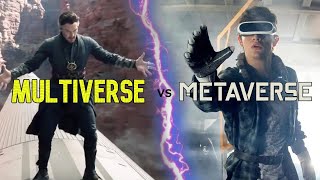
METAVERSE VS MULTIVERSE. Which is the future?
As Facebook changes its name to Meta, the focus is on the multiple virtual worlds we live in and how we interact with them. While the metaverse is still a work in progress, the concept of investing our time and engagement efforts only online isn't new. The concept of the metaverse was initially proposed in the 1992 science fiction novel Snow Crash, which was inspired by video games at the time and also alluded to the emergence of an early internet. When we use social media sites like Facebook, we travel in and out of a self-sustaining virtual environment frequently.
Because of this, the New Yorker published an article titled "We Already Live in Facebook's Metaverse." As a result, if we live in multiple places, the question arises:
Are there multiple metaverses at the same time?
Is each social media platform, online game such as Minecraft, and virtual reality ecosystem considered its own metaverse? This is where the multiverse concept comes into play. The multiverse, like the metaverse in its early years, popularized by science function and comic books, and derived from string theory in physics. The multiverse must now redefined in context as development efforts for an AR/VR-enabled metaverse gain traction. Simply put, in AR/VR, the multiverse refers to multiple disconnected worlds, similar to the original concept of co-existing universes in string theory and theoretical astrophysics. Let's look at how these two ideas connected.
What the Differences Between the Metaverse and the Multiverse?
Consider the fundamental differences between the metaverse and the multiverse to better understand these two terms.
The metaverse is being constructed, whereas the multiverse is hypothetical or exists.
The metaverse is a technology platform or environment, currently in a WIP stage. There are versions of it already available to users. The multiverse either does or doesn’t exist–it isn’t going through any sort of creation process, and scientists are only working to prove its existence.
The metaverse must be fully immersive, whereas the multiverse may contain 2D elements.
The metaverse combines AR, VR, and MR to provide a highly immersive experience. As technologies grow, its depiction of the real world will get even more accurate and it will become easier for users to move in and out of the metaverse. The multiverse may contain universes that do not resemble our own. In theory, there could be a universe with different laws of physics, and therefore, two-dimensional objects and beings.
The multiverse is not universal, but the metaverse is.
This is an important difference. As mentioned, the true metaverse will converged and universal, bringing together all the immersive worlds built by different companies. The multiverse, in contrast, has inherent multiplicity. This means that there will always be over one world, which may or may not be interoperable.
The metaverse is interoperable, whereas the multiverse's integration limited.
The metaverse is interoperable by definition, allowing users to teleport in and out of spaces, carry objects around, use the same credentials, port their NFTs, and so on.The level of interoperability in the multiverse is yet to be proven and will depend on the level of variance, as discussed.But given that we haven’t discovered the existence of a multiverse as yet, integration and interoperability are likely to be limited.
What Is the Metaverse, and How Does It Work?
The metaverse is a converged environment where users can interact with each other and the 3D world around them. It is an immersive 3D space that combines multiple AR, VR, and MR experiences to create a converged environment where users can interact with each other and the 3D world around them.
Since the rise of games like Second Life, the metaverse has been a long time in the making. Minecraft, Second Life, and other virtual reality games proposed you could exist as a 3D replica of yourself, going through similar experiences, emotions, transactions, and interactions as you would in the real world. Companies like Decentraland, Sandbox, Microsoft, and now Facebook or Meta have added a human-computer interaction element to this (HCI). You could now interact with the virtual world-scape through sensory interactions besides existing in a 3D avatar form. In the future, these companies' various metaverse platforms will converge to form a converged environment–i.e., the true metaverse.
What Exactly Is the Multiverse?
The theory of parallel universes as it exists in physics, cosmology, astronomy, and other related fields of study is known as the multiverse. The term gained popularity in the mid- and late-twentieth century because even in an infinite world, there are only a finite number of molecular combinations that can exist. As a result, matter would be compelled to repeat the same patterns eventually, resulting in universes that are like or very different from our own.
Multiverses, according to cosmologists, may exist in varying degrees of variation from our own. It could be like ours, but with a different sequence of events. In terms of basic laws, it could be like ours, but with a unique set of physical parameters. There may be multiple universes in which every combination of matter and molecules exists. Finally, there may be universes that are not even remotely related to our own and operate according to different physical laws.
What Is the Metaverse, and How Does It Work?
The metaverse is a converged environment where users can interact with each other and the 3D world around them. It is an immersive 3D space that combines multiple AR, VR, and MR experiences to create a converged environment where users can interact with each other and the 3D world around them.
Since the rise of games like Second Life, the metaverse has been a long time in the making. Minecraft, Second Life, and other virtual reality games proposed you could exist as a 3D replica of yourself, going through similar experiences, emotions, transactions, and interactions as you would in the real world. Companies like Decentraland, Sandbox, Microsoft, and now Facebook or Meta have added a human-computer interaction element to this (HCI). You could now interact with the virtual world-scape through sensory interactions besides existing in a 3D avatar form. In the future, these companies' various metaverse platforms will converge to form a converged environment–i.e., the true metaverse.
What Exactly Is the Multiverse?
The theory of parallel universes as it exists in physics, cosmology, astronomy, and other related fields of study is known as the multiverse. The term gained popularity in the mid- and late-twentieth century because of the idea that even in an infinite world, there are only a finite number of molecular combinations that can exist. As a result, matter would be compelled to repeat the same patterns eventually, resulting in universes that are like or very different from our own.
Multiverses, according to cosmologists, may exist in varying degrees of variation from our own. It could be like ours, but with a different sequence of events. In terms of basic laws, it could be like ours, but with a unique set of physical parameters. There may be multiple universes in which every combination of matter and molecules exists. Finally, there may be universes that are not even remotely related to our own and operate according to different physical laws.
Which one will emerge victorious?
The question of which will come out on top, the multiverse or the metaverse, remains to be seen. For now, the metaverse is closer to seeing a “market launch” and will have 1 billion users by 2031, as per Facebook’s estimates. The multiverse, if it exists, could have a parallel world where the metaverse designed, developed, and deployed. Ultimately, the multiverse is among the foundational rules of existence that will determine the core fabric of our lives. And eventually, a major of that life could play out in the metaverse.
The article was written by Amit Caesar.
Here are some exciting new articles you don't want to miss!
- New wearable skin lets you touch VR stuff and really feel it.
- Apple Vision Pro: The Future of Spatial Computing
- Learn a New Language in Virtual Reality Without Leaving Your Home
- Meta Quest 3: Everything you need to know
- Amazing products for your VR from Amazon
- The Best Accessories for Microsoft Flight Simulator
- Smart Contact Lenses: The Next Frontier in Augmented Reality
- Experience the future of sex with virtual reality and artificial intelligence
More News:
- UNLEASHING NATURE'S POWER: HARNESSING THE BODY'S NATURAL IONS FOR WIRELESS DATA TRANSMISSION
- META QUEST 2 ACCESSORIES
- EVERYTHING YOU NEED TO KNOW ABOUT QUEST 3 VR, RAY-BAN SMART GLASSES AND META AI
- 14 VR Games That Are Still Worth Playing
Here are the links to my social media pages:
Facebook: [link]
YouTube: [link]
LinkedIn: [link]
Twitter (x): [link]
More News:
- UNLEASHING NATURE'S POWER: HARNESSING THE BODY'S NATURAL IONS FOR WIRELESS DATA TRANSMISSION
- META QUEST 2 ACCESSORIES
- EVERYTHING YOU NEED TO KNOW ABOUT QUEST 3 VR, RAY-BAN SMART GLASSES AND META AI
- 14 VR Games That Are Still Worth Playing






